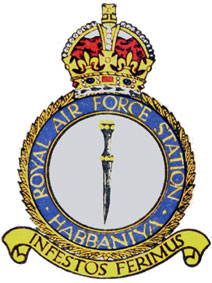RAF Habbaniya
| RAF Habbaniya | |
|---|---|

Station crest
|
|
| Active | 1936–1959 |
| Country | Iraq |
| Allegiance |
|
| Branch | Royal Air Force |
| Type | Flying station |
| Part of | British Forces in Iraq |
| Located near | Habbaniyah, Iraq |
| Royal Air Force Ensign |  |
| March | Royal Air Force March Past |
| Commanders | |
| Notable commanders |
Hughie Edwards (1956–58) |
Coordinates: 33°22′37.0″N 43°34′4.0″E / 33.376944°N 43.567778°E
Royal Air Force Station Habbaniya, more commonly known as RAF Habbaniya, (originally RAF Dhibban) was a Royal Air Force station at Habbaniyah, about 55 miles (89 km) west of Baghdad in modern-day Iraq, on the banks of the Euphrates near Lake Habbaniyah. It was operational from October 1936 until the 31 May 1959 when the British were finally withdrawn following the July 1958 Revolution. It was the scene of fierce fighting in May 1941 when it was besieged by the Iraqi Military following the 1941 Iraqi coup d'état.
It remained a major Iraqi military airbase.
RAF Habbaniya was constructed on the west bank of the Euphrates and opened on 19 October 1936. It was the British Royal Air Force base built "West of the Euphrates" in accordance with Article 5 of the Anglo-Iraqi Treaty of 1930. It was situated on the West bank of the Euphrates between Ramadi and Fallujah. The squadrons, units and headquarters and the hospital gradually moved in from [RAF Hinaidi], Baghdad, which was then vacated by the British and renamed "Rashid Airfield" by the Iraqis. Originally called RAF Dhibban, the station was renamed RAF Habbaniya on 1 May 1938. RAF Habbaniya was extensive and, as well as the airfield, included the Air Headquarters of [RAF Iraq Command], communication facilities, maintenance units, an aircraft depot, an RAF hospital, RAF [Iraq Levies] barracks, the [RAF Armoured Car Company] depot as well as fuel and bomb stores.
...
Wikipedia
